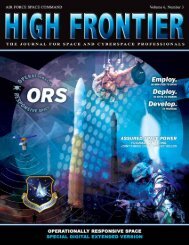Space Acquisition - Air Force Space Command
Space Acquisition - Air Force Space Command
Space Acquisition - Air Force Space Command
You also want an ePaper? Increase the reach of your titles
YUMPU automatically turns print PDFs into web optimized ePapers that Google loves.
• Establish quality program baseline/expectations and resources.<br />
• Set minimum thresholds for technology maturity.<br />
• Establish mission success as the guiding principle.<br />
• Allow program managers to trade requirements if needed.<br />
• Train and develop staff.<br />
• Clearly define authority/accountability and responsibility<br />
(including contractors).<br />
• Develop robust systems engineering.<br />
• Align contracts for success.<br />
• Budget programs to 80 percent success.<br />
• Schedule approaches to field needed capabilities rapidly.<br />
• Utilize risk-based source selection.<br />
• Pay attention to critical systems engineering processes<br />
early in the program, before making key acquisition decisions.<br />
• Reinstitute development planning.<br />
• Establish key systems engineering/program manager personnel<br />
experience and stability.<br />
The recommended solutions generally address problems<br />
at the resource level. Unfortunately, little has changed in response<br />
to these studies and their recommendations. The collective<br />
wisdom of these panels has been lost in the bureaucracy, or<br />
“astropolitics,”—and quality recommendations have basically<br />
gone unimplemented. 6 These well-meaning efforts have not<br />
changed the environment in which program mangers operate.<br />
This is unfortunate as most of the study panelists have been<br />
recognized for leadership in their professions. They have had<br />
a unique ability to shape their own personal and business environments,<br />
creating conditions for tremendous success. The authors<br />
have heard these leaders mention, in private conversation,<br />
that they participate in an earnest and patriotic hope to improve<br />
national space and defense efforts.<br />
What should be done What should we study next Defense<br />
Secretary Robert M. Gates was on-target when he told<br />
the Senate Armed Services Committee on 27 January 2009 that<br />
repairing the defense acquisition system will take more than<br />
another study. According to Secretary Gates, “Since World War<br />
II, there have been nearly 130 studies [of procurement policy]<br />
to little avail.” 7<br />
Nearly all of the studies cite institutional and resource shortcomings,<br />
inadequate budgets, insufficient institutional systems<br />
engineering and engineering talent, weak program cost and<br />
schedule reserves, volatile program funding, instable requirements,<br />
and the like. While the studies addressed these issues<br />
solidly and with sound prescriptions, they did not focus on<br />
what program managers could do specifically to better acquire<br />
a space system. A program manager must live with the reality<br />
of resource issues, especially today when the Department<br />
of Defense (DoD), US intelligence community, and National<br />
Aeronautics and <strong>Space</strong> Administration (NASA) acquisition efforts<br />
fight for priority with competing societal needs and a severely<br />
damaged economy.<br />
Limited Success of Tried Coping Strategies<br />
Given the environment of long-standing resource limitations<br />
and ever-evolving priorities, national space institutions have<br />
explored various coping strategies, some of which achieved<br />
modest success. However, these strategies did not solve the<br />
over-arching issues partly because of their top-down resource<br />
and management focus.<br />
The early years of the National Reconnaissance Office<br />
(NRO) provide a shining example of the establishment of a<br />
lean, mean, and effective space acquisition program. The NRO<br />
recognized the need for streamlined processes and procedures<br />
that would enable it to speedily and effectively achieve its significant<br />
national mission objectives. This produced intense<br />
pressure to create tight, cohesive government management<br />
teams. The rules for organizing these small management teams<br />
were set out in Battle’s Laws, which, shown in figure 1, 8 were<br />
crafted by the Corona/Discoverer satellite system director, Col<br />
Lee Battle, as part of an early effort to achieve hard-hitting,<br />
rapid success.<br />
Battle's Laws<br />
Listed more or less in their order of importance:<br />
1. Keep the program office small and quick-reacting<br />
at all cost.<br />
2. Exercise extreme care in selecting people, then<br />
rely heavily on their personal abilities.<br />
3. Make the greatest possible use of space systems<br />
development supporting organizations. You have<br />
to make unreasonable demands to make sure of<br />
this support.<br />
4. Cut out all unnecessary paperwork.<br />
5. Control the contractor by personal contact. Each<br />
man in the program office has a particular set of<br />
contractor contacts.<br />
6. Hit all flight checkout failures hard. A fault uncorrected<br />
now will come back to haunt you.<br />
7. Rely strongly on contractor technical recommendations,<br />
once the program office has performed its<br />
function of making sure the contractor has given<br />
the problem sufficient effort.<br />
8. Don't over communicate with higher headquarters.<br />
9. Don't make a federal case out of it if your fiscal<br />
budget seems too low. These matters usually take<br />
care of themselves.<br />
10. Don't look back. History never repeats itself.<br />
Figure 1. Battle’s Laws.<br />
Battle’s Laws provided an important foundation for the<br />
NRO’s early successes. A thoughtful examination reveals that<br />
Battle’s Laws are all about organizing the government program<br />
office. Early NRO management successes in acquisition, operation,<br />
and sustainment of important satellite systems were<br />
legendary, and they were accomplished through smart, lean,<br />
well-funded, empowered program offices working together as<br />
a tight-knit team with the best contractor teams in US industry.<br />
The combined government and industry teams also had<br />
the resources, gumption, mission, and the secrecy needed to<br />
survive repeated failures until major successes were achieved.<br />
High Frontier 54











